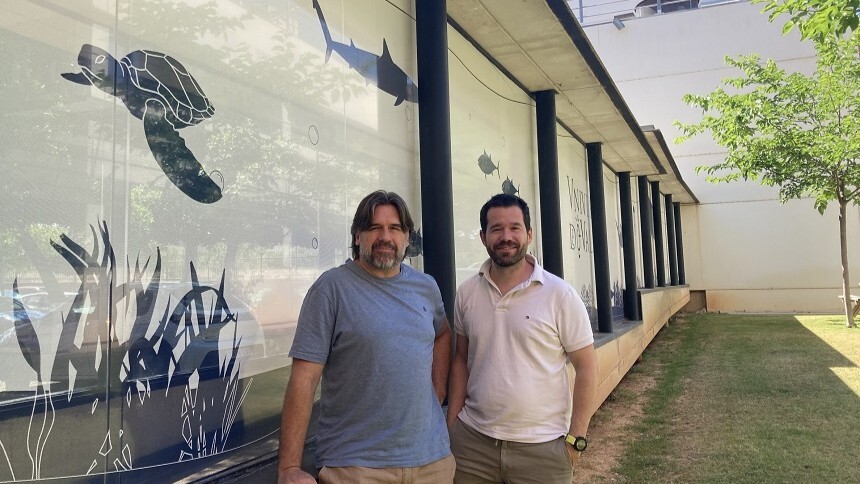The researchers Jesús Tomás and David March, from the Cavanilles Institute of Biodiversity and Evolutionary Biology (ICBiBE), participate in MegaMove, an international study supported by the UN and whose results are published in Science, in which nearly 400 scientists from 50 countries identify the most critical locations for 100 species of marine megafauna. Specifically, the two scientists investigated the movement, distribution and displacement of sea turtles in the Mediterranean, Eastern Atlantic and the Caribbean using satellite tracking systems
The work led by the Australian National University (ANU), includes sharks, whales, turtles, penguins and seals, large predators with crucial roles in marine trophic networks, facing increasing threats due to the environmental impact of human activity. Among others, one-third of this megafauna is endangered, and more than 75% of its critical habitats overlap with fishing, shipping, plastic pollution or rising temperatures. In addition, 66% of the space used by this fauna is used for critical behaviors by animals. Thus, 50% for migratory behaviour and 45% for residence behaviour such as mating, foraging or resting.
Jesús Tomás, expert in sea turtles, professor of the Department of Zoology at the Faculty of Biological Sciences and researcher at the Cavanilles Institute of Biodiversity and Evolutionary Biology (ICBiBE), located in the academic scientific area of the Science Park of the University of Valencia, highlights: "Large marine vertebrates are more difficult to study than terrestrial ones because of their difficult access; however, satellite tracking provides detailed and up-to-date information on their behaviour, habitat use, distribution and migratory routes, as well as potential man-made threats with which they may interact in their sea journeys".
"Large marine vertebrates are more difficult to study than terrestrial ones because of their difficult access; however, satellite tracking provides detailed and up-to-date information on their behaviour, habitat use, distribution and migratory routes, as well as the potential threats of human origin with which they may interact in their sea trips", Jesús Tomás, ICBiBE researcher
David March, CIDEGENT researcher of excellence at ICBiBE, who has also worked on the use of electronic systems to monitor human activities such as fishing or maritime traffic, points out: "This work allows, for the first time, to provide a global view on areas where there is a greater interaction between human pressures and marine megafauna". In previous work, these researchers had already shown that the current marine protected areas are not sufficient to conserve critical habitats for these species. Both researchers are also involved in the European LIFE OASIS project, which investigates how to protect sea turtles from abandoned fishing gear in the Mediterranean.

Specimen of turtle studied in the Mediterranean. Credit: Miquel Gomila.
Move from 8% to 30% of marine protected areas
The study published today in Science, on more than 12,000 trajectories of 110 species covering 71.7% of the oceans for 30 years, details that current marine protected areas cover only 8% of the world’s total oceans, figure that the UN High Seas Treaty seeks to expand to 30%.
The research concludes that the objectives of the current Treaty, signed by 115 countries but not yet ratified, represent a step in the right direction and will be key to driving conservation, but insufficient to cover all critical areas used by threatened marine megafauna, suggesting that additional threat mitigation measures are also needed.
The research concludes that the objectives of the current Treaty, signed by 115 countries but not yet ratified, represent a step in the right direction and will be key to driving conservation, but insufficient to cover all critical areas used by threatened marine megafauna, suggesting that additional threat mitigation measures are also needed.
"This work allows, for the first time, to offer a global view on areas where there is a greater interaction between human pressures and marine megafauna", David March, researcher at ICBiBE
Professor Ana Sequeira, ANU marine ecologist and lead author of the research, has explained that areas used by marine megafauna for important behaviors can only be found by tracking their movement patterns. They propose, in addition to protecting some areas, the implementation of mitigation strategies such as changing fishing gear, using different lights on nets and modifying traffic patterns for boats.
Research is also linked to the UN Sustainable Development Goals, Goal 14 on water, and specifically Goal A of the Global Biodiversity Framework Kunming-Montreal to stop human-induced extinction of endangered species.
Research is also linked to the UN Sustainable Development Goals, Goal 14 on water, and specifically Goal A of the Global Biodiversity Framework Kunming-Montreal to stop human-induced extinction of endangered species.
Source: UV News
- Ana M. M. Sequeira et al. Global tracking of marine megafauna space use reveals how to achieve conservation targets. Science. Vol. 388, No. 6751. DOI https://www.science.org/doi/10.1126/science.adl0239
--
Recent Posts


